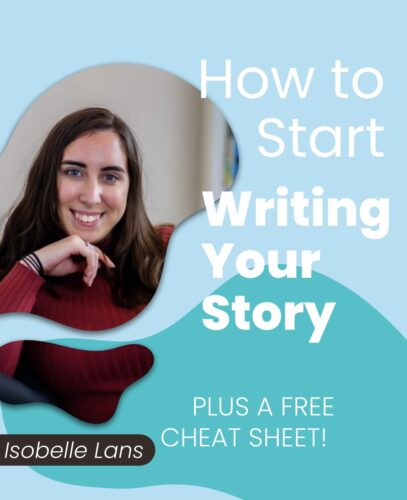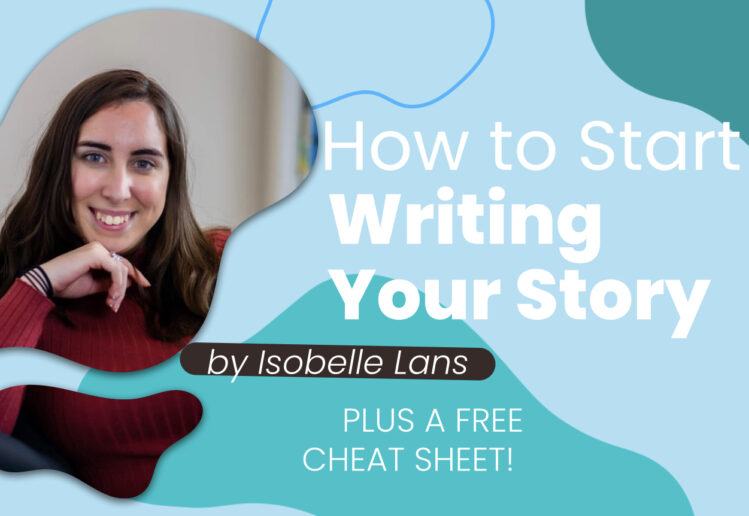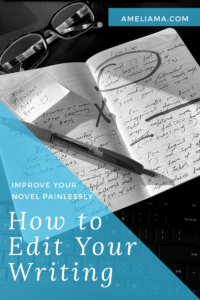
I am so excited to share Isobelle Lans’ blog on how to start writing your novel. She is a UK-based fiction writer, editor and book coach with so much knowledge to share. You’re going to be referring to this blog often. Oh, and did I mention she’s also provided a freebie to refer to when you’re looking to start your story? I adore her already, and I know you will, too!
Starting your story in the right place is crucial for hooking your readers and keeping them engaged. If you start too early you risk having too much set up, which may bore your reader. If you start your story too late you risk not having enough set up and confuse your reader. Finding that middle ground is the tricky bit.
In this blog post I’m looking at how you can start your story. Plus, I have a helpful guide to take your brainstorming further.
Where Should Your Story Start?
It’s always best practice to start as close to the Inciting Incident as possible. This doesn’t mean you should start with the Inciting Incident though.
What is the Inciting Incident?
The Inciting Incident of a book is the event that puts in motion the rest of the story. In Harry Potter and the Philosopher’s Stone, it’s when Harry learns he’s a wizard and agrees to go to Hogwarts. In The Hunger Games, it’s when Katniss volunteers as tribute in place of her sister. In Gone Girl it’s when Amy disappears.
If you’ve read any of these books you’ll know that the book doesn’t start with the Inciting Incident. The book starts a little bit before this to set up the story, the world, and the characters.
What Should Your Opening Chapters Include?
Depending on the story you’re telling, the pacing, and your style, you may not start your story where most people do. However, generally speaking, there are a few essentials your book needs to have in the opening before you get to the Inciting Incident.
Things to set up in your opening:
• Who is your main character and what is their place in the world? (eg: Katniss and her family live in District 12, the poorest of all districts. Katniss often hunts illegally, so she can feed her family. From this we know that life is harsh, but that Katniss is selfless and resourceful.)
• What does their everyday life look like? (eg: Katniss hunts in the woods with her friend Gale and trades what she can for other foods and goods. Katniss is the one who provides for her family after her father died.)
• Where is this story taking place? (e.g. we learn about the districts as well as the day of the reaping. We are told how the reaping works with the names of everyone between twelve and eighteen being entered, as well as the history of their country and The Hunger Games itself.)
• Which characters are important to establish early on? Hint: this may be friends, enemies, love interests, parents, etc. (e.g. we meet Katniss’s mother and sister and see their strong bond. We are also introduced to her friend and love interest, Gale.)
• What potential conflicts can you foreshadow? (e.g. obviously, The Hunger Games is the main conflict and the first chapter establishes a sense of foreboding around the reaping.)
What Is the Purpose of the Pre-Inciting Incident Chapters?
You may think that you need to start your story with a bang by throwing your protagonist in at the deep end. However, allowing for some set up to take place before the Inciting Incident is crucial and there are a few reasons for this.
- Your reader needs to understand who your character is before the Inciting Incident. You need to show us who they are, what their everyday life looks like, and what is important to them. The reader needs to have a strong understanding of the kind of character they are so we can understand them once their life changes after the Inciting Incident.
- To introduce the stakes. What is at stake for your protagonist (i.e. what they have to win or lose) may be in those opening chapters. Perhaps they are working towards something at the beginning and the Inciting Incident offers them a chance to achieve it. Perhaps they are the sole provider for their family, and it is their family’s wellbeing that is at stake. You can set up the stakes by introducing early on what the protagonist needs and wants and what is important to them.
- To establish the motivation and goal. Your protagonist should have a clear motivation and goal from the start. This goal and motivation may change throughout the book, but there should be something that they are working towards at the beginning. It could be providing for their family like the above example, it could be to get from one place to another, it could be to right a past wrong. Their goal and motivation could be anything, but whatever it is, it should be at least hinted at in those early chapters, so the reader can get a sense of what the character is working towards.
What Should You Consider When Opening Your Chapters?
Your opening chapters set the tone (quite literally) for the rest of the book. So, you need to make sure that what you’re promising in the beginning is delivered in the end and that your opening is representative of the story you are telling.
What do I mean by this?
Don’t make a misleading first impression. If your book is super serious and gritty, don’t start with a lighthearted first chapter. If your protagonist is witty and funny, don’t introduce them as being a stick in the mud.
Here’s what you should consider:
• Establish a clear narrative voice. This is both your narrative style and the character’s voice. Is the point of view character snarky and sarcastic? Make sure that’s clear in the first few pages. Do you have a beautiful, flowery style of writing? Establish that early on.
• Set the tone. Make sure your tone is consistent to the story you’re writing, whether it’s dark, funny, lighthearted, tense, whatever. It’s important that that tone is clear straight away, so the reader knows early on what kind of story you’re telling.
• Set the scene. Make sure you’re placing your readers in your story, so they feel grounded in the setting. They should be able to understand where they are when the story opens and what’s taking place around them to avoid confusion.
• Foreshadow conflicts and stakes. If you can, hint at the possible threats or conflicts that your protagonist may encounter. Think of this like a breadcrumb trail that builds up to the major conflicts of the story.
• Introduce the main theme(s). You should try to establish your themes early on so they can develop and expand throughout the story. Themes can be difficult to pinpoint. Ultimately, it comes down to what your story is about at its rawest form. (e.g. Harry Potter’s main theme is death, The Hunger Games’s main theme is survival, and Gone Girl’s main theme is manipulation. When you strip away the plot, these themes are what these books are really about. We see these being introduced very early on.)
The first few chapters, and certainly the very first one, are known to be difficult because there is a great sense of pressure around getting them right. Your first chapters are a promise to the reader of what they can expect from your characters and your story. As long as you’re hitting on the above points, you can’t go too far wrong.
Find the Start of Your Story
If you would like to dig into how you can set up your story, download this free guide to take you through brainstorming:
Meet the Author
At Inspired Creative Co., Isobelle lans works with writers at all stages of the writing journey to help them grow, learn, and develop their storytelling skills through personalised and solutions-based feedback. You can connect with her on Instagram where she shares writing advice and insights, or you can learn more about her on her website.
And, you can also find Isobelle listed under the Author Resources page.






[…] How to Start Writing Your Story […]